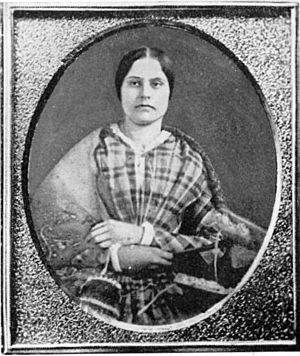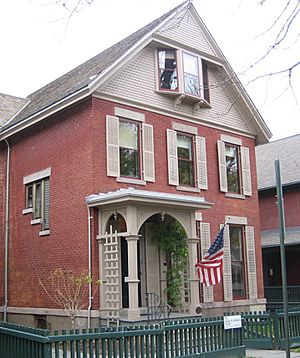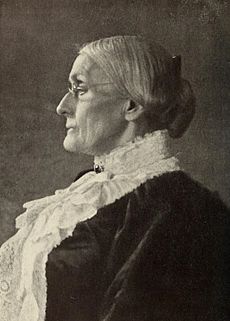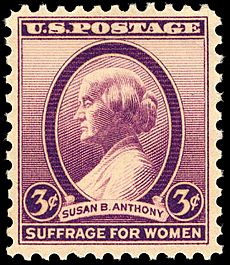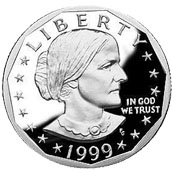Susan B. Anthony facts for kids
Quick facts for kids
Susan B. Anthony
|
|
|---|---|
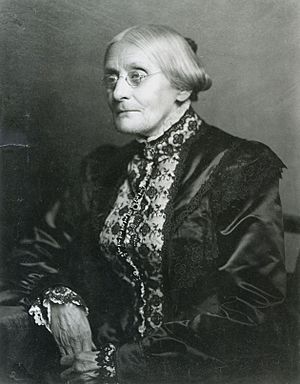
Anthony in 1890
|
|
| Born |
Susan Anthony
February 15, 1820 Adams, Massachusetts, U.S.
|
| Died | March 13, 1906 (aged 86) Rochester, New York, U.S.
|
| Resting place | Mount Hope Cemetery (Rochester, New York) |
| Known for | Advocacy of |
| Relatives | Daniel Read Anthony (brother) Mary Stafford Anthony (sister) Daniel Read Anthony Jr. (nephew) Susan B. Anthony II (great-niece) |
| Signature | |
Susan B. Anthony (born Susan Anthony; February 15, 1820 – March 13, 1906) was an important American leader. She worked for social change and women's rights. She played a big part in the movement to get women the right to vote. This movement is called women's suffrage.
Contents
Early Life and Family
Susan Anthony was born on February 15, 1820, in Adams, Massachusetts. Her parents were Daniel and Lucy Anthony. She was the second of seven children.
Her father was a Quaker, and her mother was a Baptist. They raised their children in a way that was open to different ideas. Susan's father taught all his children, both girls and boys, to be independent. He taught them about business and gave them responsibilities early on.
When Susan was six, her family moved to Battenville, New York. Her father managed a large cotton mill there. Before that, he had run his own small cotton factory.
A Family of Activists
Susan's family cared a lot about making society better. Her brothers, Daniel and Merritt, moved to Kansas. They supported the movement to end slavery, known as abolitionism. Merritt even fought with John Brown against people who supported slavery during a time called Bleeding Kansas. Daniel later owned a newspaper and became the mayor of Leavenworth.
Susan's sister, Mary, lived with Susan in later years. Mary became a public school principal in Rochester. She also became a women's rights activist. Susan's father was also active in the fight against slavery and for the temperance movement, which aimed to reduce alcohol use.
Susan's Education and First Job
When Susan was seventeen, she went to a Quaker boarding school in Philadelphia. She only stayed for one term. Her family faced financial trouble because of an economic crisis called the Panic of 1837. They had to sell everything they owned. Luckily, Susan's uncle bought most of their belongings and returned them to the family.
To help her family, Susan left home to teach at a Quaker boarding school. In 1846, she moved to Canajoharie. There, she became the headmistress of the female department at the Canajoharie Academy.
When Susan was 26, she started to change her style. She dressed less simply and stopped using formal Quaker speech. She became interested in social reform because she noticed she was paid less than men for doing the same job. This bothered her a lot.
Becoming an Activist
In 1845, Susan's family moved to a farm near Rochester, New York. They met other Quaker reformers there who had left their church. In 1848, this group formed a new organization called the Congregational Friends. They met on Sunday afternoons at the Anthony farm.
When the Canajoharie Academy closed in 1849, Susan took over running the family farm. This allowed her father to focus on his insurance business. However, Susan felt more drawn to working for social change. She became very active in reform movements. For the rest of her life, she mostly earned money by giving speeches.
Susan became interested in the more radical ideas of people like William Lloyd Garrison and Elizabeth Cady Stanton. She even tried wearing the Bloomer dress, which had pantaloons under a knee-length dress. But she stopped after about a year. People focused more on her clothes than on her important ideas.
Working with Elizabeth Cady Stanton
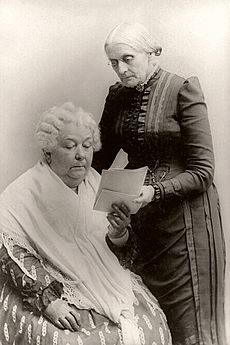
In 1851, Susan met Elizabeth Cady Stanton. They became lifelong friends and partners in working for social change. Susan was once not allowed to speak at a temperance conference because she was a woman. After this, she and Stanton started the New York Women's State Temperance Society. Most of their work together focused on women's rights.
During the American Civil War, they created the Women's Loyal National League. This group gathered almost 400,000 signatures to support ending slavery. It was the largest petition in the United States at that time.
After the war, they started the American Equal Rights Association. This group worked for equal rights for both women and African Americans. In 1868, they began publishing a women's rights newspaper called The Revolution.
A year later, the women's movement split into different groups. Anthony and Stanton founded the National Woman Suffrage Association. This was separate from another group called the American Woman Suffrage Association. In 1890, the two groups joined together to form the National American Woman Suffrage Association. Susan was a strong leader in this new group.
Starting in 1876, Anthony and Stanton worked with Matilda Joslyn Gage. They began writing what became a six-volume book series called History of Woman Suffrage.
In 1878, Anthony and Stanton helped present an amendment to Congress. This amendment would give women the right to vote. Senator Aaron A. Sargent introduced it. It later became known as the Susan B. Anthony Amendment. This amendment was finally approved in 1920 as the Nineteenth Amendment to the U.S. Constitution.
Even though their interests changed over the years, Anthony and Stanton remained close friends.
Susan B. Anthony's Trial
In 1872, Susan Anthony was arrested in her hometown of Rochester, New York. She had voted, even though at that time, only men were allowed to vote. She was found responsible for breaking the law at her trial. However, she refused to pay the fine, and the authorities did not take further action against her. This act of defiance brought attention to the cause of women's suffrage.
Public Speaking and Global Work
Susan gave many speeches, sometimes 75 to 100 each year, to support women's right to vote. She also worked on many campaigns for women's rights in different states and countries. She helped create the International Council of Women, which is still active today. She also helped organize the World's Congress of Representative Women at the World's Columbian Exposition in Chicago in 1893.
Later Life and Legacy
When Susan first started speaking about women's rights, some people made fun of her. They even accused her of trying to ruin marriage. But during her lifetime, people's opinions about her changed a lot. President William McKinley invited her to the White House to celebrate her 80th birthday. She became the first female citizen to be shown on a U.S. coin. Her picture appeared on the 1979 dollar coin.
When she was 71, Susan agreed to live with her sister Mary Stafford Anthony in Rochester. Before that, she had lived in hotels and with friends or relatives. Her energy and determination were amazing, sometimes even tiring out her co-workers. At age 75, she explored Yosemite National Park riding on the back of a mule.
She stayed active in the suffrage movement. In 1896, she spent eight months working on the California suffrage campaign. She gave speeches up to three times a day in more than 30 places. In 1900, she led her last NAWSA convention.
In her final six years, Susan spoke at six more NAWSA conventions and four congressional hearings. She also finished the fourth volume of the History of Woman Suffrage. She traveled to eighteen states and to Europe. As Susan's fame grew, some politicians were happy to be seen with her.
Personal Life
As a teenager, Susan went to parties. When she was older, she received marriage proposals. However, there is no record of her ever having a serious romance. Susan B. Anthony never married. She said she did not want to give up her independence.
Susan said she loved children. When she was not traveling, she spent time with the children in the Stanton household.
Death
Susan B. Anthony died at age 86 from heart failure and pneumonia. She passed away in her home in Rochester, New York, on March 13, 1906. She was buried at Mount Hope Cemetery, Rochester. Many people were sad when Susan died.
Famous Quotes from Susan B. Anthony
- “Woman must not depend upon the protection of man, but must be taught to protect herself.”
- “Men, their rights, and nothing more; women, their rights, and nothing less.”
- “There never will be complete equality until women themselves help to make laws and elect lawmakers.”
- “Failure is Impossible.”
- “I don't want to die as long as I can work; the minute I can not, I want to go.”
Interesting Facts About Susan B. Anthony
- She was named after her grandmother, Susanah, and her father's sister, Susan.
- When Susan was young, she and her sisters added middle initials to their names. Susan chose "B." because her Aunt Susan had married a man named Brownell.
- Frederick Douglass, a former slave and a famous abolitionist, was Susan's lifelong friend.
- Susan B. Anthony's writings and papers are kept in important libraries like Harvard University and the Library of Congress.
- She helped write a six-volume book series called History of Woman Suffrage (1881).
- Her home in Rochester is a National Historic Landmark. It is now called the National Susan B. Anthony Museum and House.
- Her birthplace in Adams, Massachusetts, and her childhood home in Battenville, New York, are also important historic sites.
Susan B. Anthony's Impact
When Susan B. Anthony died, women had already gained the right to vote in a few states, like Wyoming, Utah, Colorado, and Idaho. More large states soon followed. Married women also had more legal rights in most states. Women were starting to work in many different jobs and attend colleges and universities.
The Nineteenth Amendment, which gave women the right to vote, became known as the Susan B. Anthony Amendment. After it was approved in 1920, the National American Woman Suffrage Association changed its name to the League of Women Voters. This group is still active in U.S. politics today.
Honoring Susan B. Anthony
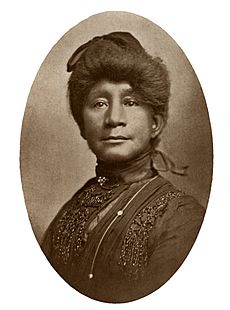
- In 1950, Susan B. Anthony was added to the Hall of Fame for Great Americans. A statue of her was placed there in 1952.
- In 1973, Anthony was inducted into the National Women's Hall of Fame.
- The first memorial to Anthony was created by African Americans. In 1907, a year after her death, a stained-glass window was placed in the African Methodist Episcopal Zion church in Rochester. It showed her picture and the words "Failure is Impossible."
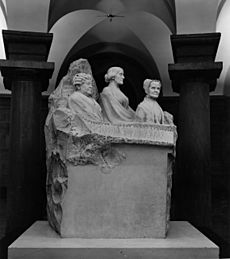
- Anthony is honored along with Elizabeth Cady Stanton and Lucretia Mott in a sculpture called Portrait Monument. It is located in the United States Capitol Building and was revealed in 1921.
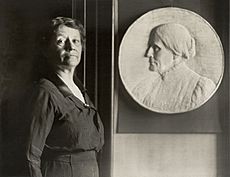
- In 1922, sculptor Leila Usher gave a bas-relief (a type of sculpture) of Susan B. Anthony to the National Woman's Party.
- In 2001, the Cathedral of St. John the Divine added a sculpture honoring Anthony and three other important figures: Martin Luther King Jr., Albert Einstein, and Mahatma Gandhi.
- On February 15, 2020, Google celebrated Anthony's 200th birthday with a special Google Doodle on their homepage.
- Susan B. Anthony Day is a special holiday on February 15th, her birthday. It celebrates her birth and women's right to vote in the United States.
Banknotes, Coins, and Stamps
- The U.S. Post Office issued its first postage stamp honoring Anthony in 1936. This was 16 years after the 19th Amendment was approved. A second stamp honoring Anthony was issued in April 1958.
- In 1979, the United States Mint started making the Susan B. Anthony dollar coin. It was the first U.S. coin to honor a female citizen.
Awards and Organizations Named After Her
- Since 1970, the Susan B. Anthony Award has been given every year. The New York City chapter of the National Organization for Women gives it to "grassroots activists dedicated to improving the lives of women and girls in New York City."
See also
 In Spanish: Susan B. Anthony para niños
In Spanish: Susan B. Anthony para niños
- List of civil rights leaders
- List of suffragists and suffragettes
- List of women's rights activists
- Timeline of women's suffrage
- Timeline of women's suffrage in the United States
- Women's suffrage organizations
- Susan B. Anthony dollar
- Susan B. Anthony Day


